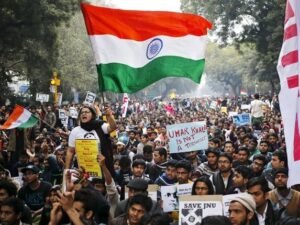What is MGNREGA?
- MGNREGA is the world’s largest social security programme.
- It provides all rural households in India with 100 days of unskilled physical labour.
- The MGNREG Act grants rural residents the right to work.
- It makes it mandatory for the government to provide them with jobs on demand. Household could sue them if they don’t comply.
- The majority of the time, the work is on projects to construct long-lasting assets such as roads, canals, ponds, and wells.
- In actuality, there are numerous restrictions on how the funds can be spent.
- A minimum wage-to-material ratio of 60:40 is mandated by the Act.
- In 2016-17, the average daily wage per person was $161.
Objective of NREGA
- On September 7, 2005, the Mahatma Gandhi National Rural Employment Guarantee Act (MGNREGA) was notified.
- The Act’s mandate is to give at least 100 days of guaranteed paid employment to every rural home whose adult members volunteer to conduct unskilled manual labour in a financial year.
Benefits of MGNREGA scheme
- Employment Guarantee Scheme: Within six months of the Act’s enactment, each state government must implement a “Employment Guarantee Scheme.”
- Permitted works: Schedule I of the Act contains a list of permissible works. These mostly deal with water conservation, small irrigation, land development, and rural roadways, among other things. The Schedule does, however, enable “any additional work that the Central Government may notify in collaboration with the State Government.”
- A “Programme Officer” will be in charge of coordinating the Rural Employment Guarantee Scheme at the Block level. The Act, on the other hand, empowers him to delegate any of his tasks to the Gram Panchayats.
- Implementing agencies: “implementing agencies” will carry out REGS projects. Gram Panchayats are the most important of them, but implementing agencies might also include other Panchayati Raj Institutions, line ministries such as the Public Works Department or the Forest Department, and non-governmental organisations (NGOs).
- Contractors: The use of private contractors is prohibited.
- Decentralized planning: The Programme Officer will keep a shelf of projects based on recommendations from the implementing agencies. Each Gram Panchayat is also required to produce a list of works based on the Gram Sabha’s recommendations.
- Transparency and accountability: The Act includes provisions for periodical Gram Sabha social audits, mandatory disclosure of muster rolls, public accessibility of all REGS papers, and regular updating of job cards, among other things.
Salient Features of MGNREGA
- Adult members of a rural household who are willing to conduct unskilled manual labour may apply in writing or orally to the local Gram Panchayat for registration.
- A Job Card will be issued by the Gram Panchayat following proper verification. The Job Card, which is free of charge, will include a photograph of all adult members of the home who are willing to work under MGNREGA.
- Within 15 days of receiving an application, the Job Card should be issued.
- A Job Card holder may submit a written employment application to the Gram Panchayat, detailing the time and length for which work is required.
- A minimum of fourteen days of employment is required.
- The Gram Panchayat shall issue a dated receipt of the written employment application, against which the 15-day employment guarantee will operate.
- If employment is not provided within 15 days of an application for work, daily unemployment benefits must be paid in accordance with the Act. The states are responsible for the provision of unemployment benefits.
Significance of MGNREGA
- One in four persons lives below the poverty line in rural India. Ever since the launch of this scheme in 2006, it has changed the nature of the rural labour market.
- It gave an opportunity to rural households to earn minimum income by getting job cards under this scheme. There are 12 crore job cards as of today.
- While the poor have used it to climb out of poverty, the not-so-poor used it as a measure to supplement their income by working during lean agriculture periods.
- Furthermore, the scheme is inclusive, with a higher percentage of women and people from the SC and ST groups participating.
- Currently, nearly one out of every two employment produced under the scheme is for women, with about 40% of SC/ST occupations.
- It is a first-time earning opportunity as well as a chance at empowerment for many women.
- Surprisingly, the initiative has also assisted households in escaping the clutches of local money lenders.
- Payments under the scheme are now primarily made by direct deposit into beneficiary accounts, forcing people to register 10 million new bank or post office accounts.
- Access to bank credit has been enhanced by the newly established accounts. Some studies even suggest that children in MGNREGA households receive better schooling.
What is the role of Gram Sabha in MGNREGS?
- Under the Act, the Gram Sabha (GS) has the following powers and responsibilities:
- It sets the priority of works at Gram Sabha meetings, taking into account the potential of the local region, its requirements, and local resources.
- Keep an eye on the work being done in the GP.
- It is the major venue for social audits to be conducted.
- It provides a platform for all inhabitants to request and get all necessary information about MGNREGA works implemented in the GP area from all Implementing Agencies, including GP.
What are the Roles of Gram Panchayat in MGNREGS?
The Gram Panchayat (GP) is in charge of the following responsibilities: i. Accepting registration applications ii. Verifying registration applications iii. Registering households iv. Issuing Job Cards (JCs) v. Accepting job applications v. Providing dated receipts for these job applications.
Issues with MGNREGA
MGNREGA provides chances for our fellow residents to earn a living and establishes a minimum wage for low-income earners, especially in cities. However, with such a large budget for this programme, one legitimate concern is whether the government is receiving the most bang for its buck. The system compel the government to provide employment, but it does not monitor productivity or the long-term viability of the work done thus far. The slow speed of work is one of the criticisms.
Workers have a motivation to produce as much as is required to earn the wage rate, but there is no incentive to expedite or complete the assignment on time.
There are also administrative issues. Because Panchayat Samitis do not meet for months at a time, work sanctioning is delayed. In 2015-16, only 10% of the 4.8 crore households were able to fully benefit from 100 days of labour.
FAQs
What is the Mandate of Mahatma Gandhi National Rural Employment Guarantee Act (MGNREGA)?
A. The mandate of the MGNREGA is to provide at least 100 days of guaranteed wage employment in a financial year to every rural household whose adult members volunteer to do unskilled manual work.
When was Mahatma Gandhi National Rural Employment Guarantee Act passed by the Indian Parliament?
B. The Indian Parliament passed the Mahatma Gandhi National Rural Employment Guarantee Act on 23rd August 2005.
When was the Mahatma Gandhi National Rural Employment Guarantee Act Notified?
C. The Mahatma Gandhi National Rural Employment Guarantee Act was notified through the Gazette of India (Extraordinary) Notification dated September 7, 2005; it came into force on February 2, 2006 in 200 backward districts.



